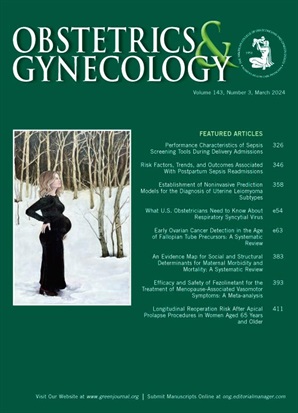Coronavirus Disease 2019 (COVID-19) Vaccination and Spontaneous Abortion.
IF 4.7
2区 医学
Q1 OBSTETRICS & GYNECOLOGY
引用次数: 0
Abstract
OBJECTIVE To examine the association between coronavirus disease 2019 (COVID-19) vaccination and spontaneous abortion. METHODS We conducted a case-control study of clinically adjudicated spontaneous abortions (case group) occurring between January 19, 2021, and October 27, 2021, and live births (control group). Patients aged 16-49 years at eight Vaccine Safety Datalink sites who had singleton pregnancies, one or more prenatal visits, continuous health plan enrollment, and spontaneous abortion (fetal loss between 6 and less than 20 weeks of gestation) or live birth were eligible. A random sample of eligible patients with spontaneous abortions was adjudicated to confirm pregnancy outcome, outcome date, and gestational age at fetal death; patients in the adjudicated spontaneous abortion case group were matched 1:2 on Vaccine Safety Datalink site, maternal age, and pregnancy start date with eligible patients with live births. Vaccine exposure was considered from pregnancy start to spontaneous abortion date or equivalent gestational age for the matched live births (index date). Conditional logistic regression was used to evaluate the association between COVID-19 vaccination in pregnancy and spontaneous abortion; secondary analyses explored associations by dose number, vaccine manufacturer, and vaccination within 6 weeks of the spontaneous abortion. RESULTS Matched analyses included 296 patients in the spontaneous abortion case group and 592 in the live birth control group. There was no association between spontaneous abortion and COVID-19 vaccination (adjusted odds ratio [aOR] 0.85, 95% CI, 0.56-1.30). There was also no association between spontaneous abortion and dose number compared with no vaccine (one dose: aOR 0.81, 95% CI, 0.39-1.70; two doses: aOR 0.84, 95% CI, 0.51-1.38; vaccine manufacturer: Moderna aOR 0.59, 95% CI, 0.29-1.19 and Pfizer-BioNTech aOR 0.97, 95% CI, 0.57-1.66; or vaccine exposure window of 6 weeks before spontaneous abortion or index date: aOR 0.87, 95% CI, 0.53-1.44). CONCLUSION There was no observed association between COVID-19 vaccination in pregnancy and spontaneous abortion. Findings support the safety of COVID-19 vaccination in early pregnancy.2019冠状病毒病(COVID-19)疫苗接种和自然流产。
目的探讨2019冠状病毒病(COVID-19)疫苗接种与自然流产的关系。方法对2021年1月19日至2021年10月27日期间发生的临床裁定的自然流产(病例组)和活产(对照组)进行病例对照研究。在8个疫苗安全数据链接站点,年龄16-49岁的单胎妊娠、一次或多次产前就诊、连续健康计划登记、自然流产(妊娠6周至少于20周的胎儿丢失)或活产的患者符合条件。随机抽取符合条件的自然流产患者,确认妊娠结局、结局日期和胎儿死亡时的胎龄;经裁定的自然流产病例组患者在疫苗安全数据链网站、产妇年龄和妊娠开始日期与符合条件的活产患者进行1:2匹配。从妊娠开始到自然流产日或匹配活产的同等胎龄(索引日)考虑疫苗暴露。采用条件logistic回归评价妊娠期接种COVID-19疫苗与自然流产的相关性;二次分析探讨了自然流产后6周内剂量、疫苗生产商和疫苗接种的相关性。结果自然流产组296例,活育组592例。自然流产与COVID-19疫苗接种无关联(校正优势比[aOR] 0.85, 95% CI, 0.56-1.30)。与未接种疫苗相比,自然流产与剂量数也没有关联(单剂量:aOR 0.81, 95% CI, 0.39-1.70;两剂:aOR 0.84, 95% CI 0.51-1.38;疫苗制造商:Moderna or 0.59, 95% CI 0.29-1.19, Pfizer-BioNTech or 0.97, 95% CI 0.57-1.66;或自然流产前6周或指数日期前的疫苗暴露窗口:aOR 0.87, 95% CI, 0.53-1.44)。结论妊娠期接种COVID-19疫苗与自然流产无相关性。研究结果支持妊娠早期接种COVID-19疫苗的安全性。
本文章由计算机程序翻译,如有差异,请以英文原文为准。
求助全文
约1分钟内获得全文
求助全文
来源期刊

Obstetrics and gynecology
医学-妇产科学
CiteScore
11.10
自引率
4.20%
发文量
867
审稿时长
1 months
期刊介绍:
"Obstetrics & Gynecology," affectionately known as "The Green Journal," is the official publication of the American College of Obstetricians and Gynecologists (ACOG). Since its inception in 1953, the journal has been dedicated to advancing the clinical practice of obstetrics and gynecology, as well as related fields. The journal's mission is to promote excellence in these areas by publishing a diverse range of articles that cover translational and clinical topics.
"Obstetrics & Gynecology" provides a platform for the dissemination of evidence-based research, clinical guidelines, and expert opinions that are essential for the continuous improvement of women's health care. The journal's content is designed to inform and educate obstetricians, gynecologists, and other healthcare professionals, ensuring that they stay abreast of the latest developments and best practices in their field.
 求助内容:
求助内容: 应助结果提醒方式:
应助结果提醒方式:


